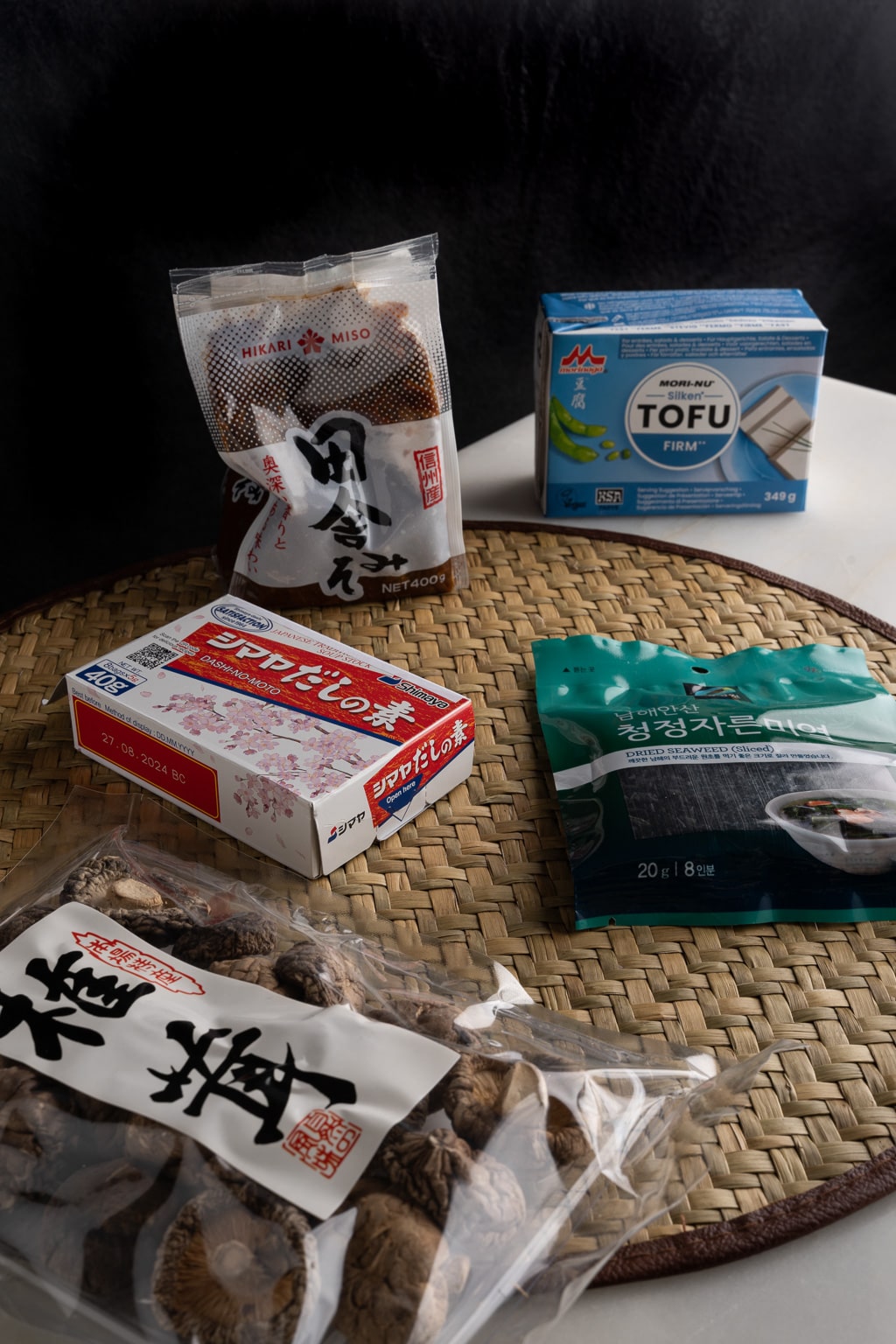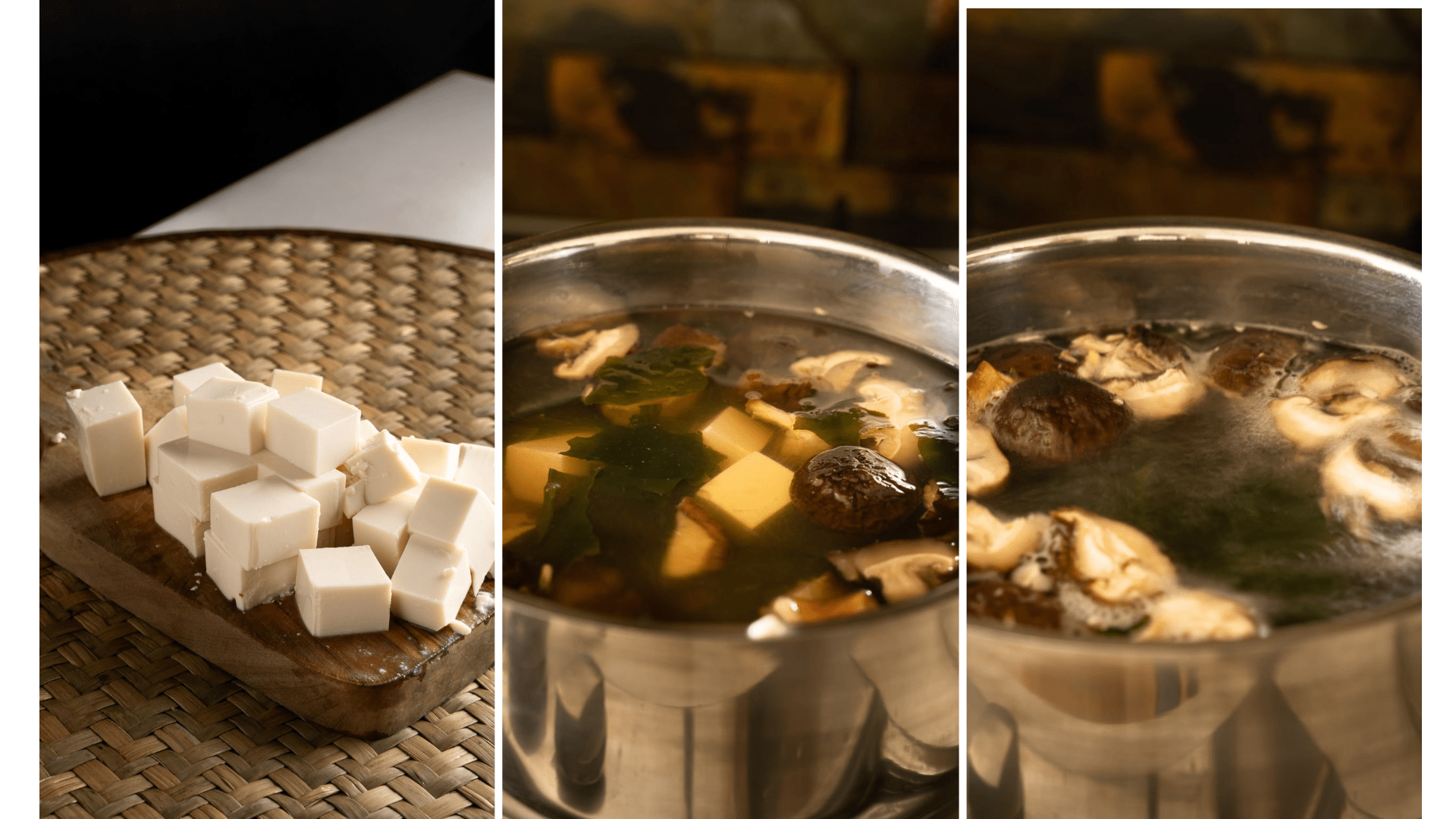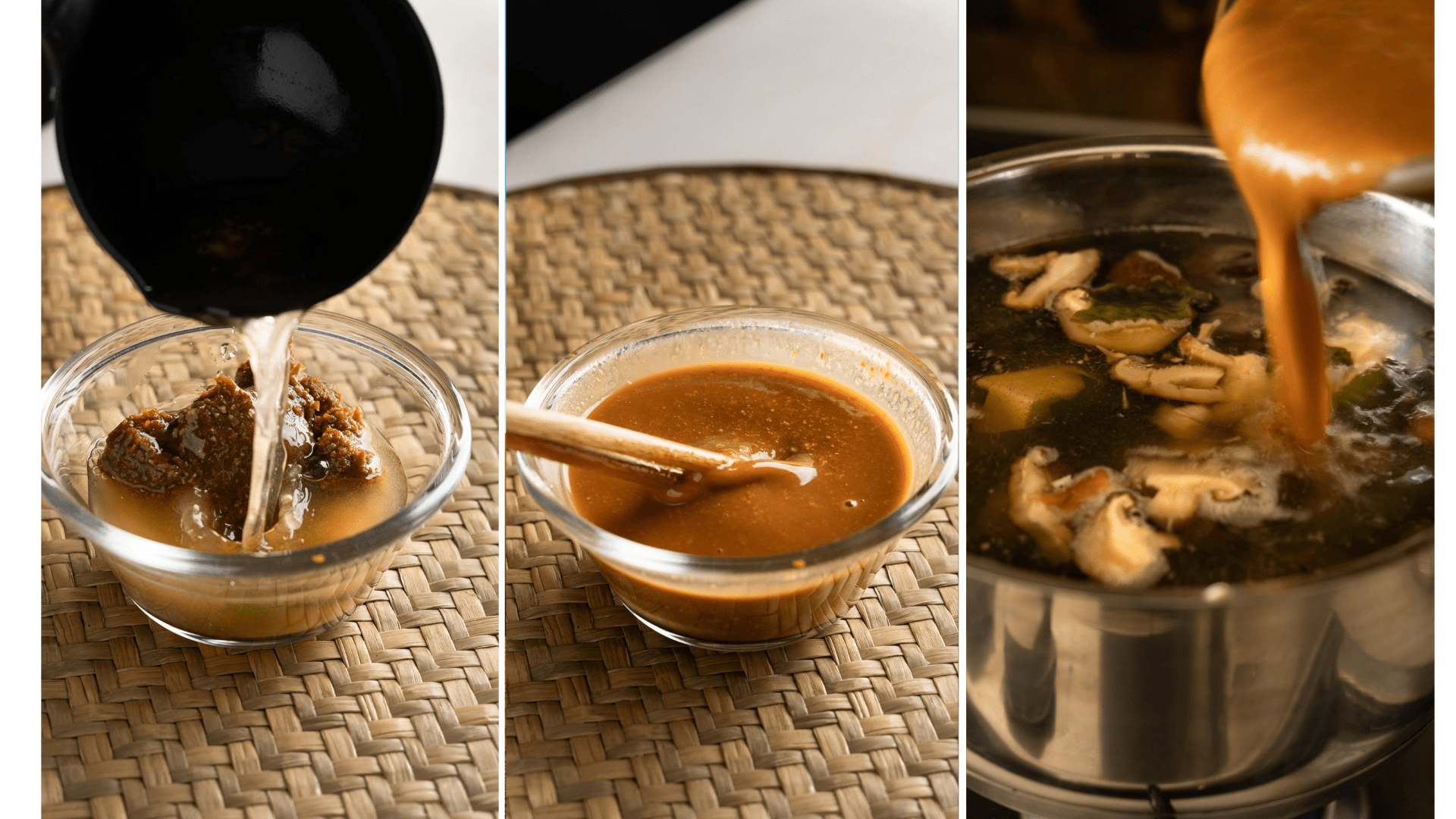Homemade Miso Soup
Miso soup is among the quickest, simplest, and most effortless soups you can prepare. Miso soup is light, nutritious, full of flavor, warm and comforting. Furthermore, it is low in calories and carbs, so you can enjoy it without compromising your diet.
This particular recipe features shiitake mushrooms, wakame, tofu, and a flavorful broth, and it comes with customizable variations to adapt to the ingredients you have on hand.
Enjoy a steaming bowl of this nutritious miso soup at home!
The recipe requires:
5 Ingredients
Active cooking time: 5 minutes
Total cooking time: 40 minutes

Table of Contents
Miso Soup Health Benefits
Here are the health benefits of the ingredients used in this miso soup recipe and their nutritional value per 100 g/3.5 oz:
Red Miso Paste:
- Rich in probiotics that support gut health.
- Contains vitamins, minerals, and antioxidants.
- May help lower the risk of certain chronic diseases.
Calories: 210 | Protein: 12g | Fat: 6g | Carbohydrates: 27g | Dietary Fiber: 7g | Net Carbs: 20g | Sodium: 5000mg
Dashi Powder
- Dashi is a good source of essential minerals.
- Low in calories and can be used as a flavorful base.
- Different types of broths provide various health benefits, such as collagen in bone broth.
Calories: 45 | Protein: 5.3g | Carbohydrates: 9.1g |Dietary Fiber: 6.4g | Net Carbs: 2.7g | Sodium: 9000mg
Silken Tofu:
- High in plant-based protein.
- Rich in essential amino acids.
- Low in saturated fat and calories.
Calories: 53 | Protein: 4.8g | Fat: 2.5g | Carbohydrates: 2g | Dietary Fiber: 0.2g | Net Carbs: 1.8g | Sodium: 10mg
Dried Wakame:
- Abundant in essential vitamins and minerals.
- Contains antioxidants that may support heart health.
- A good source of dietary fiber.
Calories: 45 | Protein: 5.3g | Carbohydrates: 9.1g | Dietary Fiber: 6.4g | Net Carbs: 2.7g | Sodium: 9000mg
Dried Shiitake Mushrooms:
- High in vitamins and minerals, including vitamin D.
- Rich in antioxidants that help combat inflammation.
- May support immune function and overall health.
Calories: 296 | Protein: 12g | Carbohydrates: 65g | Dietary Fiber: 20g | Net Carbs: 45g | Sodium: 15mg
Why you will love this recipe
This recipe of miso soup is:
- Quick and easy to make
- Low in carbs in calories
- Nutritious and healthy
- Rich in umami taste
- Comforting and warm, perfect for chilly days
- Customizable

Miso Soup Recipe
Ingredients
To make homemade miso soup, you will need the following ingredients:
- 2 tbsp. miso paste (I prefer red miso paste for its deep umami flavor and saltiness, but feel free to use your favorite type or a combination of them).
- 1 tsp. (5 g/one package) dashi powder + 700 ml (3 cups) of water OR other broth options such as vegetable/mushroom, bone/fish broth, or chicken bouillon, depending on your preference.
- 200 g silken tofu (traditionally used but can also use firm tofu).
- 2-3 tsp. dried wakame.
- 6 pieces of dried shiitake mushrooms + 150 ml (0.5 cup) of water
For garnish:
- Roasted sesame seeds.
- Chopped scallions.
- Microgreens.
You can find these ingredients at Asian or Japanese stores or purchase them online.

Equipment
Gather these essential tools for making miso soup:
- Cutting board and knife
- Small-medium bowl, fork/ chopsticks/whisk/ miso muddler to dissolve miso paste
- Medium pot to cook miso soup
- Ladle spoon to serve soup
How to make Miso Soup
Step 1. Hydrate dried shiitake mushrooms.
To quickly hydrate dried shiitake mushrooms, use one of the methods below:
- Boiling water. Boil water and place the dried mushrooms in a heatproof bowl. Pour the boiling water over the mushrooms until they are completely submerged. After that, cover the bowl with a lid or and allow the mushrooms to soak for about 20-30 minutes.
- Microwave. Place the dried mushrooms in a microwave-safe bowl and add just enough water to submerge the mushrooms. Then, microwave on high for 2-3 minutes or until the water comes to a boil. Allow the mushrooms to sit in the hot water for about 10-15 minutes.
Step 2.Fill the pot with the ingredients.
Meanwhile, fill a pot with 700 ml (3 cups) of water and add dashi powder and dried wakame. Alternatively, use one of the broths you have. See the notes for that in the post.
Let the wakame hydrate and soak up the water until it becomes soft and flexible.

Then, add the hydrated shiitake mushrooms with the water they were soaked in.
Bring the pot with the ingredients to a boil and then reduce the heat, allowing it to simmer for about 5 minutes.

Step 3: Dice the tofu.
Meanwhile, cut the tofu into cubes and add it to the pot. Simmer for about 2 minutes.

Step 4: Dissolve the miso paste.
Next, dissolve the miso paste. For that, put the miso paste into a bowl. Then, ladle some broth from the pot into the bowl and stir the miso paste until no pieces remain.
Add the miso mixture to the pot, stir everything together gently, and heat it, but don’t let it boil. Turn off the heat before it starts boiling.

Serve with your preferred garnish.
Enjoy a warm, nutritious miso soup and stay healthy!

Tips for homemade miso soup
- Don’t boil the miso. This is very important, as high temperature will destroy nutrients, flavors and aromas from the soup. Turn off the heat before it boils, you can use the kitchen thermometer to read the temperature (95 C/ 203 F).
- Dissolve miso paste before adding it to the soup. Miso paste doesn’t dissolve easily, so you need to dissolve it before adding it to the soup with other ingredients to avoid any lumps.
- Stir the soup gently after adding the tofu in it, trying not to crush it. Often tofu is cutted directly in the palm to avoid crushing it as it has a very soft, fragile structure, but be careful if you’ll try to do it.
Recipe variations
Here are some variations to customize your miso soup:
Broth: You can choose the type of broth to match your dietary preferences. For a vegan or vegetarian version, use vegetable broth, which keeps the soup light and plant-based. If you prefer a more hearty and flavorful option, go for fish, bone broth, or chicken bouillon.
Protein: To make your miso soup more filling and protein-rich, consider adding extra protein sources. Sliced fish, bacon, or diced chicken are excellent choices that complement the savory umami of the soup.
Miso Paste: Experiment with different types of miso paste. Traditional red or white miso is commonly used, but there are various miso varieties available, each with its unique flavor profile. Try a few to find your favorite.
Greens: Incorporate leafy greens like spinach, bok choy, or scallions for added nutrition and freshness. These greens enhance the texture and flavor of the soup.
Seaweed: Dried wakame and kombu are common choices. These seaweeds introduce a pleasant oceanic essence and provide a wealth of minerals.
Feel free to combine these variations to craft your perfect bowl of miso soup, tailored to your taste and dietary preferences.
Enjoy the rich umami and comforting warmth of your customized miso creation.

FAQ
How to store miso soup?
Allow the soup to cool completely, then store it in a pot, sealed container, or a covered bowl in the fridge for up to 2 days.
On which diets can you enjoy miso soup?
Miso soup can be enjoyed on various diets, depending on how it’s prepared and the specific dietary requirements. Here are some diets on which miso soup can be incorporated:
- Vegetarian and Vegan diets: Miso soup can be adapted to a vegetarian diet by using vegetable or mushroom broth instead of dashi, and by choosing vegetarian miso paste.
- Keto and Low-Carb diets: Miso soup can be keto-friendly if you choose ingredients carefully and control portion sizes. Use miso paste in moderation, opt for low-carb broth options, and incorporate keto-friendly ingredients like silken tofu, low-carb vegetables, and seaweed. Just be mindful of the carbohydrate content in the specific miso paste you choose.
- Gluten-Free Diet: While miso paste is traditionally made from soybeans, it may contain barley or other grains, which could be a source of gluten. To make gluten-free miso soup, choose miso paste labeled as gluten-free, and ensure that all other ingredients are gluten-free as well.
- DASH Diet. The Dietary Approaches to Stop Hypertension (DASH) diet encourages the consumption of nutrient-dense, lower-sodium foods. A low-sodium miso soup, with reduced salt, can be incorporated into the DASH diet. The key is to prepare the soup with lower-sodium miso and broth.
In summary, miso soup is versatile and can be adapted to suit a variety of dietary preferences and restrictions. It’s a nutritious and flavorful option for those following different diets, as long as you make ingredient choices that align with your specific dietary needs and goals.
Nutritional value
Total carbohydrate 10 g
Dietary fiber 0.6 g
Total sugars 2.7 g
Net carbs 9.4 g
Total fat 0.6 g
Saturated fat 0.1 g
Cholesterol 0 mg
Sodium 598 mg
Calcium 30 mg
Iron 1 mg
Potassium 120 mg
Disclaimer: The nutritional value provided is based on general information and should not be considered as a substitute for professional dietary advice or medical guidance. The values are derived from reputable sources, such as food databases or nutritional labels, but there may be variations in nutrient content depending on factors such as brand, preparation methods, and serving sizes.
Try these keto recipes next:

Homemade Miso Soup
Quick and nutritious homemade miso soup recipe: easy to make, low in calories and carbs, with shiitake mushrooms, wakame, tofu, and more.
Ingredients
- 2 tbsp. miso paste
- 1 tsp. (5 g/one package) dashi powder + 700 ml (3 cups) of water OR other broth options such as vegetable/mushroom, bone/fish broth, or chicken bouillon, depending on your preference.
- 200 g silken tofu (traditionally used, but you can also use firm tofu).
- 2-3 tsp. dried wakame.
- 6 pieces of dried shiitake mushrooms. + 150 ml (0.5 cup) of water
For garnish:
- Roasted sesame seeds
- Chopped scallions
- Microgreens
Instructions
- First, hydrate dried shiitake mushrooms. To quickly hydrate dried shiitake mushrooms, use one of the methods below:
- Boiling water. Boil water (150 ml/0.5 cup) and place the dried mushrooms in a heatproof bowl. Pour the boiling water over the mushrooms until they are completely submerged. After that, cover the bowl with a lid or and allow the mushrooms to soak for about 20-30 minutes.
- Microwave. Place the dried mushrooms in a microwave-safe bowl and add just enough water (150 ml/0.5 cup) to submerge the mushrooms. Then, microwave on high for 2-3 minutes or until the water comes to a boil. Allow the mushrooms to sit in the hot water for about 10-15 minutes.
- Meanwhile, fill a pot with 700 ml (3 cups) of water and add dashi powder and dried wakame. Alternatively, use one of the broths you have. See the notes for that in the post.
- Let the wakame hydrate and soak up the water until it becomes soft and flexible.
- Then, add the hydrated shiitake mushrooms with the water they were soaked in.
- Bring the pot with the ingredients to a boil and then reduce the heat, allowing it to simmer for about 5 minutes.
- At the same time, cut the tofu into cubes and add it to the pot. Simmer for about 2 minutes.
- Next, dissolve the miso paste. For that, put the miso paste into a bowl. Then, ladle some broth from the pot into the bowl and stir the miso paste until no pieces remain.
- Add the miso mixture to the pot, stir everything together gently, and heat it, but don’t let it boil. Turn off the heat before it starts boiling.
- Serve with your preferred garnish. Enjoy a warm, nutritious miso soup and stay healthy!
Notes
To store: allow the soup to cool completely, then store it in a pot, sealed container, or a covered bowl in the fridge for up to 2 days.
Save the recipe!
Pin this card so you can find it later
1 thought on “Homemade Miso Soup”
Can you be more specific about the content of your article? After reading it, I still have some doubts. Hope you can help me.